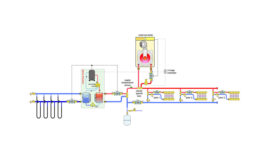Radiant & Hydronics
Case Study
New school meets energy efficiency needs with pre-insulated PEXa pipe
High-performing district heating application facilitates a high-quality experience for students and teachers.
February 19, 2024
Most Popular Products
Plumbing & Mechanical Top 20 Products of 2023
Check out 2023’s most popular products based on pageviews from PM’s website.
February 14, 2024
Case Study
Amish Hardware Store with smart hydronics technology
Keystone Air Power, Lebanon County’s fastest-growing hardware store, is a robust Amish enterprise full of surprises.
February 12, 2024
Hydronics Workshop | John Siegenthaler
Options for connecting heat pumps to existing boiler systems
Tie ins
February 1, 2024
Boilers offer path to greener future
More electric boiler options entering the market.
January 17, 2024
Heat pumps maximize efficiency, combining hot water and space heating
The road to electrification and decarbonization.
January 15, 2024
Celebrating the illustrious career of a renowned hydronics industry voice
Industry legend Dan Holohan retires from writing.
January 15, 2024
Radiant heating provides zoned comfort and efficiency to log cabin home
New Jersey hydronics pro passes his knowledge to the next generation.
January 11, 2024
Keep your content unclogged with our newsletters!
Stay in the know on the latest plumbing & piping industry trends.
JOIN TODAY!Copyright ©2025. All Rights Reserved BNP Media.
Design, CMS, Hosting & Web Development :: ePublishing













